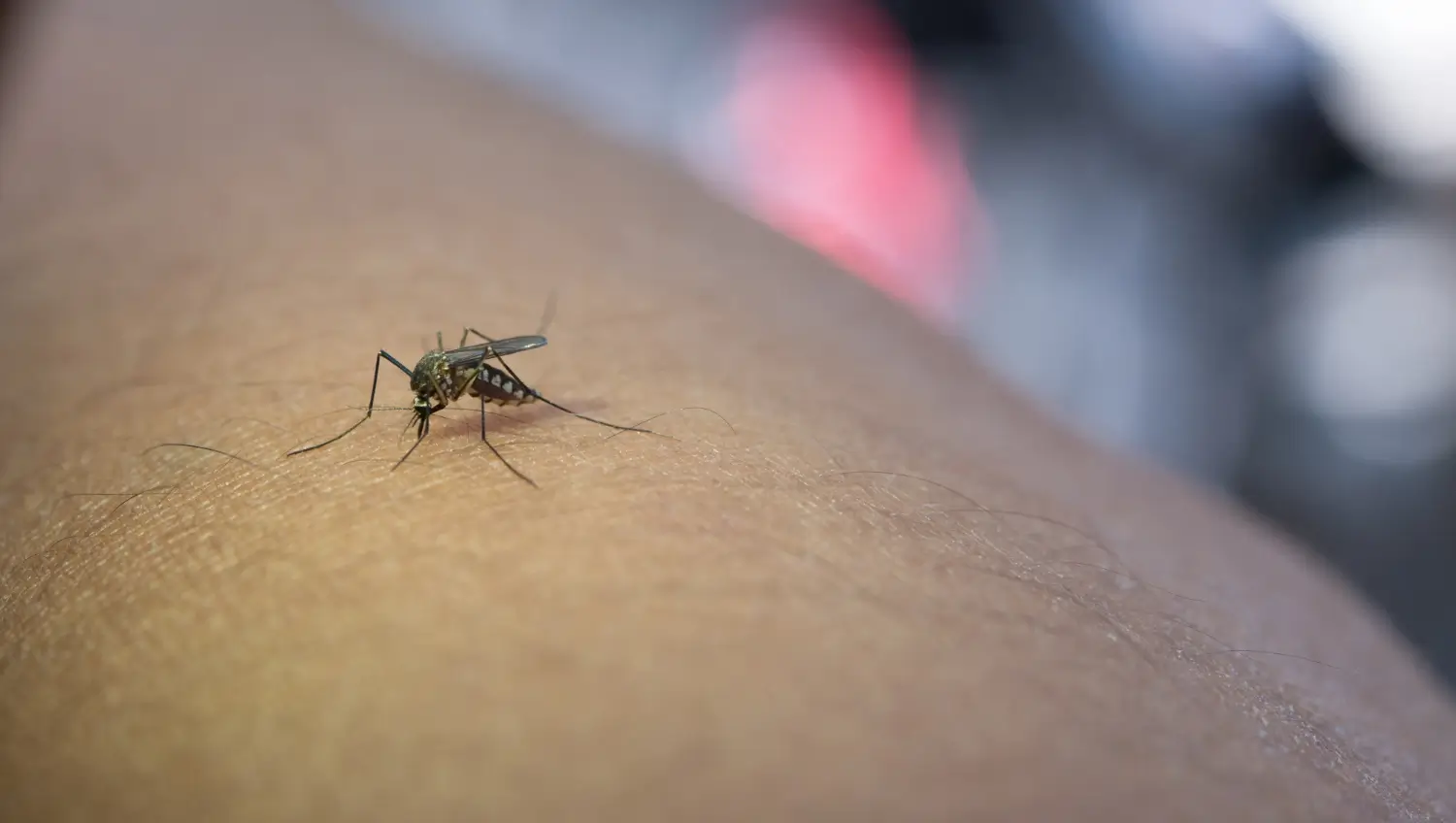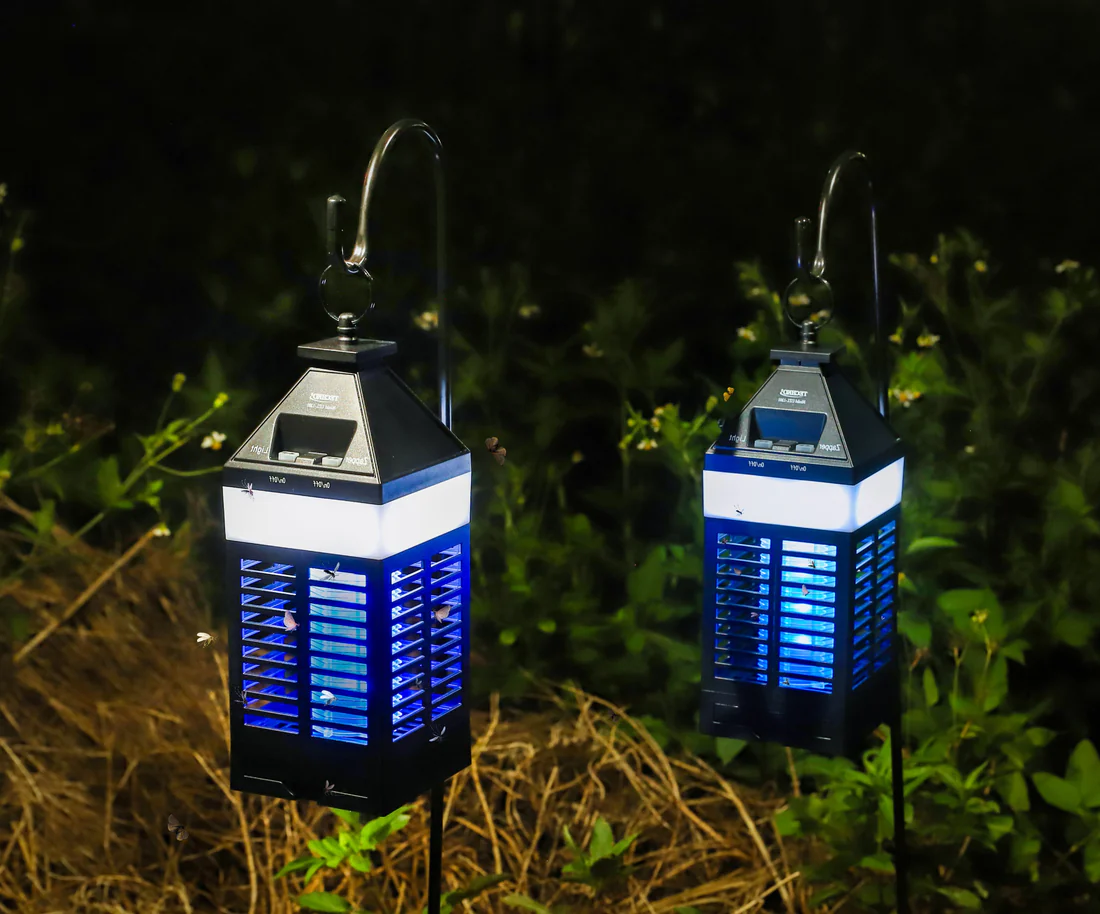- Bug zappers use UV light to lure flying insects, which then get electrocuted when they contact an electrified grid.
- When selecting a bug zapper, it's important to consider factors like indoor vs. outdoor use, coverage area, and power source (electric or solar).
- Although bug zappers are a chemical-free solution, they can be effective against mosquitoes but may harm beneficial insects, such as bees.
Imagine a tranquil evening outside maybe in the backyard or on a patio. The cooler breeze and gentle noises of nature make it the best time to hang out with friends or family. But the silence is suddenly broken by the buzzing of mosquitoes and other insects. Whether attempting to eat, to converse or to simply relax, those little pests can ruin a moment in no time.
To solve this problem, bug zappers are used to kill insects indoors and outdoors. These gadgets, which are frequently spotted hanging in gardens or on patios, eliminate flying pests without much fuss. They lure insects in with ultraviolet (UV) light, then kill the bugs with electricity when they make contact with the grid.
MEET THE EXPERT
- ■
Joseph M. Conlon is a technical advisor & former Executive Director, AMCA, with 40+ years advising on mosquito-control, including UV light traps; provides guidance for CDC, Consumer Reports, NPR and NY Times.
- ■
Dr. Michael J. Raupp runs the "Bug of the Week" outreach channel and is frequently interviewed by publications like the Washington Post, NPR, and National Geographic on the efficacy and environmental impact of yard bug zappers.
Understanding Bug Zappers
A bug zapper is a device that kills insects, such as flies, mosquitoes, moths, wasps, and other such insects, that are attracted by light. It functions with the help of an ultraviolet (UV) light, which lures insects to it. When a bug makes contact with an electrified grid, it is electrocuted and killed, thus ridding the home of a common household pest.
ℹ
Mechanism of Action
Bug zappers lure bugs by shining UV light, an illumination that's visible to many flying insects, including mosquitoes. The light serves as bait, attracting the insects to the zapper. As soon as an insect approaches the unit, it touches the electrified grid. The grid is charged with a high voltage current, effectively killing the insect upon contact. The corpses then fall through to the bottom of the unit, allowing them to be easily cleaned out.
How Bug Zappers Work?
Bug zappers use ultraviolet light and an electrified grid to zap and kill flying insects effortlessly.
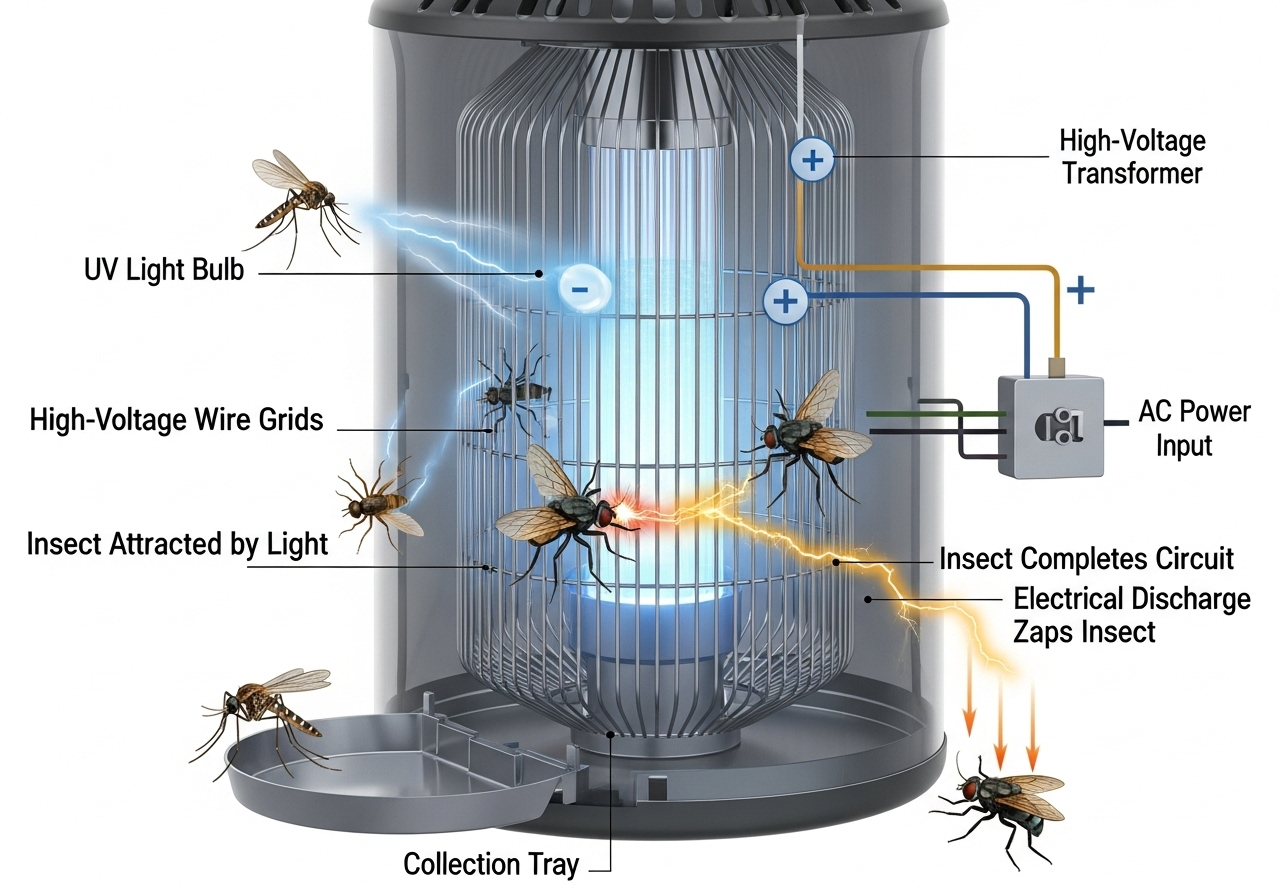
1. Attraction
Bug zappers mainly use ultraviolet (UV) light from a special bulb to lure insects to them.
- Nocturnal creatures such as moths and mosquitoes are instinctively attracted to UV light through the phenomenon of phototaxis, which leads them to fly towards light sources used for night-time navigation.
- UV light is attractive to insects, resembling the natural light sources, like the moon, which insects rely on for orientation.
- The bug light also creates heat (like plants or animals), making it more appealing to bugs.
- This mix of light and heat also makes bug zappers extremely attractive for use in low-light and dark outdoor spaces like gardens and patios, or indoors after dusk.
2. Electrocution Process
As insects are drawn to the bug zapper, they fly towards an electrified metal grid and become electrocuted.
- And the grid is charged with high voltage (1,000-3,000 volts).
- When insects make contact with the grid, they are electrocuted immediately.
- The electrocution happens fast, and some zappers will vaporize the bug or store it in a tray.
- The “zap” and flashes of light that occur simultaneously with electrocution can draw even more insects to the zapper, perpetuating the cycle.
3. Design Variations
Bug zappers come in various designs, and there are some essential distinctions between them based on their usage:
- Traditional Plug-In Models: These are the most popular bug zappers out there. They require a plug to an electrical outlet and are primarily used outdoors, although some have been designed for indoor use. They come in all different sizes and can cover large sections.
- Solar-Powered Units: These bug zappers are instead powered by solar panels. They are safe for the environment and do not need a power outlet, making them ideal for outdoor applications in locations without power. They’re usually smaller and meant to be hung in gardens or patios.
- Handheld Electric Swatters: They are small battery-operated zappers that enable users to physically swat and kill insects. They look like a small tennis racket and are useful for zapping individual pests inside or out.
- Indoor vs. Outdoor Models:
- Indoor Models: Created for residence or office applications, these versions may be smaller and quieter. They are to be placed on counters or hung near doors and windows to trap indoor flying insects.
- Outdoor Models: These are bigger and stronger systems that can tackle much larger areas like backyards or patios. They tend to be more rugged, and weather proofed, and built for use outdoors.
Pros and Cons of Bug Zappers
Bug zappers provide a convenient way of managing flying insects, but they have both advantages and disadvantages that should be weighed before using.
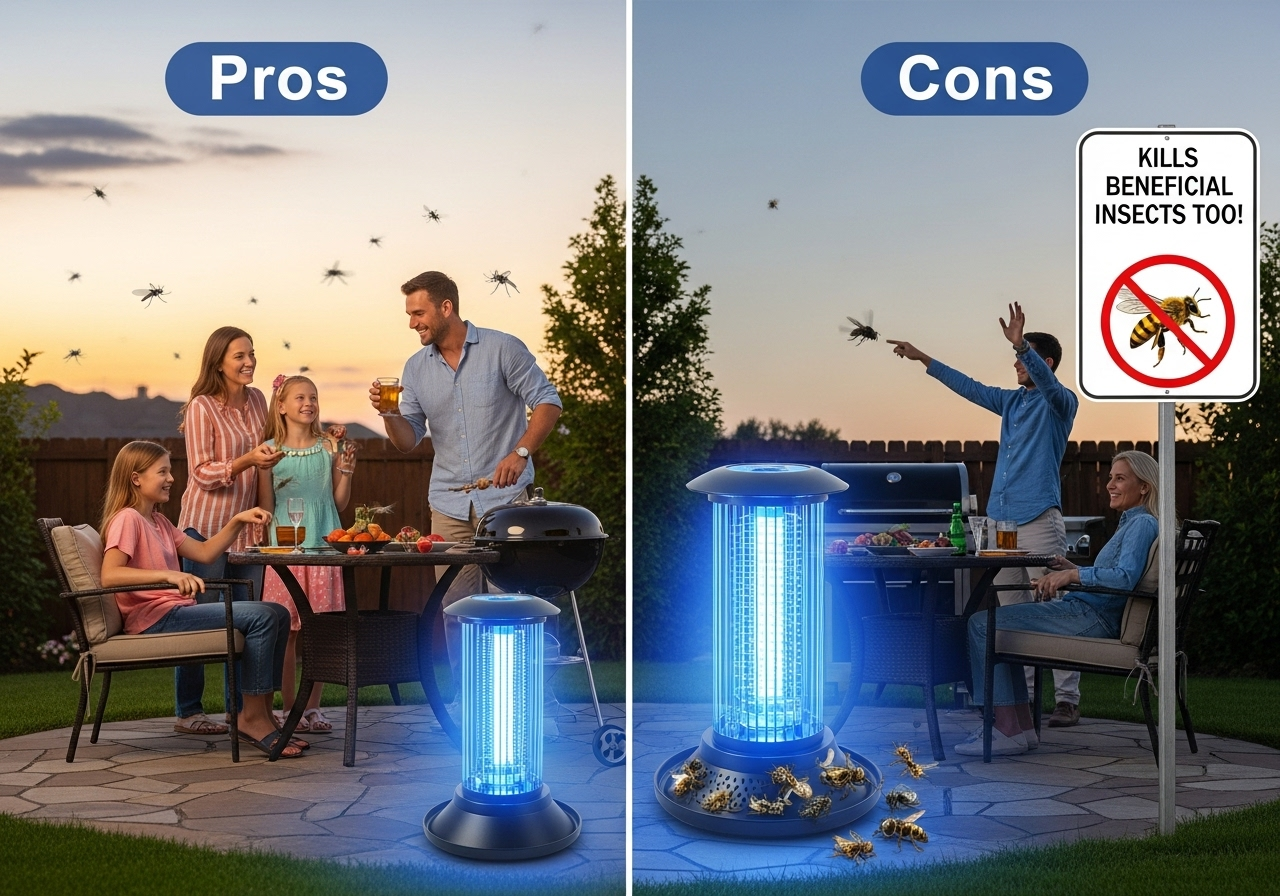
Pros
- Chemical-Free Pest Control: This is a bug zapper that does not use any chemical substances or pesticides such as sprays, bait or trapping means. Bug zappers, as opposed to sprays or insecticides, don’t require toxic chemicals, which means they are far safer for people and their pets.
- Ease of Use: Bug zappers are easy to install and operate. Once plugged in or turned on, they go to work attracting and killing insects on their own. They are convenient because people don’t have to actively do anything.
- Large Area Coverage: Most bug zappers, especially options for the outdoors, cover a lot of ground. This one is great for bigger areas, like backyards, camping, or even for outdoor seating at a restaurant.
- Low Maintenance: Usually, people don’t have to do much to a bug zapper to make sure it functions properly. Other than occasionally cleaning out dead bugs and making sure it is being powered adequately, you can largely set it and forget it.
Cons
- Non-Targeted Killing of Beneficial Insects: Bug zappers can eliminate many insects, as they can not differentiate between good and bad bugs. They frequently attract and kill insects that are more ecologically important like bees, moths and other acini-pollinators.
- Limited Effectiveness Against Mosquitoes: Mosquitoes are not very attracted to the UV light of the bug zapper because they are more attracted to carbon dioxide and body heat that people emit. For that reason, bug zappers generally aren’t a major help in reducing the mosquito population and are less than ideal for those who only want to target these types of pests.
- Potential Spread of Insect-Borne Diseases: Insect-borne illnesses could be inadvertently disseminated by the use of a bug zapper. When insects are zapped, tiny particles of their body, or of any pathogens they are transporting, can be released into the air. This may have some health implications.
- Noise and Light Pollution: Some bug zappers, particularly those designed for outdoor use, are loud and disruptive. The noise of insects being killed can be unpleasant for anyone trying to relax in the vicinity.
- Ongoing Maintenance Required: While most bug zappers are relatively maintenance free, they do require periodic cleaning. Dead insects may collect in the instrument, blocking the grid and interfering with its effectiveness.
- Electricity Consumption: Even though bug zappers are generally low-power gadgets, they still use electricity. This is less of an issue for those devices powered by the sun; at the same time, rechargeable electric zappers can ramp up overall power and waste, particularly when they’re used in open-air accommodations.
Best Bug Zapper for Backyard and Indoor Use
Here, look at some of the most effective bug zappers for sale at Growcycle and what sets them apart from the rest.
1. Pic 2-in-1 Bug Zapper
The Pic 2-in-1 Bug Zapper is a combo product designed for maximum convenience and room coverage. This makes it perfect for both indoor and outdoor use and a great choice for camping, in the backyard and other outdoor activities.
With a rechargeable lithium-ion battery, it can work for up to 20 hours on a full charge. This unit not only kills flying insects but it also serves as a night-time light, so the guests are not left in the dark.
2. GREEN-STRIKE 800V Solar Elektra 600 Bug Zapper
The GREEN-STRIKE 800V Solar Elektra 600 Bug Zapper is great for those who want an eco-friendly solution. This zapper for mosquitoes has a built-in solar panel to charge a rechargeable battery, and covers a 600 square foot range while using an 800V high-voltage grid to kill bugs.
Its weatherproof body means people can use it in the garden and not have to worry about the rain, and its 6-8 hour working time on a full charge at least makes it a dependable outdoor option for gardens, patios or pathways. This bug zapper also functions as a path light to illuminate any pathway around the home.
3. GREEN-STRIKE 4000V Elektra Bug Zapper 1800 Series
The GREEN-STRIKE 4000V Elektra Bug Zapper 1800 Series is even stronger and suitable for up to 1,800 square feet which is perfect for larger outdoor spaces. This zapper has a 24 Watt UV-A light and a 4000V high-voltage grid, making this zapper an ultra-effective fixture in eliminating bugs.
Use it indoors and outdoors, and in tough to reach areas that need pest protection. This machine is great for mosquitoes and other insects and will have a long-lasting effect in large indoor spaces.
4. Pic Solar Lantern Zapper
The Pic Solar Lantern Zapper is functional and attractive. This solar bug zapper will protect up to half an acre, making it a great garden gadget or the best outdoor zapper.
The lantern-shaped trap covers up to 1,000 sq ft to provide even more light and even more protection. The rugged weatherproof case can withstand the elements so the user can mount it anywhere.
5. Pic Portable Lantern and Insect Zapper
Another flexible option for outdoor insect control is the Pic Portable Lantern and Insect Zapper. This is an ideal portable device to take to camping, backyards, or outdoor events. It is a rechargeable lantern and works as a lantern and an insect killer.
The fact that it does both of these things makes it a very convenient choice for anyone who wants to improve their meals by keeping insects at bay without necessarily sacrificing the light.
How to Choose the Right Bug Zapper
There are some things to keep in mind when choosing the bug zapper that is right:
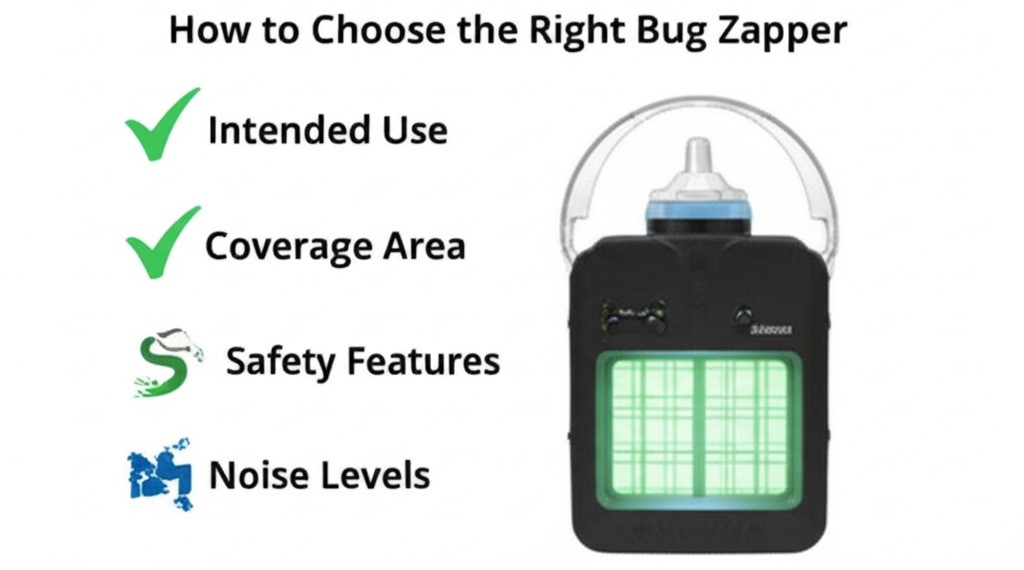
- Intended Use (Indoor vs. Outdoor): Indoor bug zapper reviews will say they are smaller and quieter, which is perfect for compact areas like kitchens or even an office. Outdoor models are bigger, sturdier, and have been designed to handle the elements, so user can take them to the patio, garden, or campsite.
- Coverage Area: Select a bug zapper with a coverage area based on where you plan to use it. The smaller models are designed to cover a maximum of 600 sq ft, while the largest run up to 1,800 sq ft or more. It’s crucial to size the space to the zapper’s coverage for maximum effect.
- Power Source (Electric vs. Solar): If going for an electric model, the unit will have to plug in and is generally stronger, always running at its best. These solar models are environmentally friendly, use sunlight to charge during the day, and work well in outdoor spaces that don’t have easy access to electricity. They tend to be less powerful, but are more energy efficient.
- Safety Features: Consider units with guard grids or protective covers to avoid accidental contact with the electric grid, especially if you have children or pets. These aspects offer additional security to ensure the zapper is safe and efficient.
- Noise Levels: Outdoor models tend to be noisier due to the sound of insects being electrocuted, while indoor models are quieter. If the zapper will be used in a peaceful environment, choosing a quieter model can help maintain tranquility.
Safety and Maintenance Tips
Correct installation, cleaning, and safety measures will help make the bug zapper work effectively and safely.
- Mounting Height and Location: When it comes to placing a bug zapper, the height also matters, and where you locate it can be a big factor for its effectiveness. For outdoor units, suspend the zapper at least 5 to 6 feet off the ground in order to draw insects from a larger surrounding area. For indoor use, simply place it near doors or windows where bugs are known to enter.
- Distance from Human Activity: Place the bug zapper away from human activity so the sound of zapping bugs doesn’t bother anybody. It should also be placed away from places that people could accidentally touch it.
- Regular Cleaning to Ensure Effectiveness: Clean the bug zapper regularly to keep it efficient. Bugs can get caught in it, impeding airflow and weakening the punch of the wind. Resort to the manual of the manufacturer to know how to clean; a soft brush or rag will suffice to get rid of dead insects and dirt.
- Handling Dead Insects Safely: When cleaning the zapper, handle dead insects carefully, particularly if the zapper has a high-voltage grid. Always turn off the device before cleaning and use gloves to avoid direct contact with any dead insects or contaminated surfaces.
- Avoiding Contact with the Electric Grid: Avoid any contact with the electric grid of an insect killer because it is high voltage. Always wait until the zapper is off before cleaning or changing anything. Many of today's zappers include protective covers to reduce accidental contact.
- Mosquito Zapper Safe for Pets: Make sure the mosquito zapper is installed in a position where children and pets can't touch it. Find models with child-safe aspects such as protective grids or covers that keep fingers away from the electrified grid. Observe the safety and handling instructions of the device manufacturer.
FAQs
What features should I look for when buying a bug zapper?
When purchasing a bug zapper, consider its intended use (indoors or outdoors), coverage area size, power source (electric or solar), safety features (such as a protective grid), and noise level. People should also factor in the maintenance needs as well as whether the zapper is a tough, weatherproof design for outdoor use.
Do bug zappers actually work?
Bug zappers, it turns out, can be useful for killing flying insects, though in a limited way. But they are not particularly effective against mosquitoes, which are much more drawn to body heat and carbon dioxide than UV light.
How to tell if a bug zapper is working?
To see if a bug zapper is effective, try to hear if there is a “zap” sound when bugs touch the electric grid. Also, check the catch tray or base of the unit for dead bugs. If the zapper is not drawing or killing insects, it may be time to clean it or replace the bulb.
Summary
Bug zappers provide a simple, chemical-free way to reduce flying insects, and with these products people don’t have to worry about stinky sprays or oily lotions that can leave skin feeling greasy or sticky. These products use UV light to attract insects and zap them with an electric shock. They work for indoor or outdoor settings, but the effectiveness may vary. Regular cleaning and good installation can also help to ensure that the zapper works effectively and safely.
For efficient pest control, visit Growcycle to purchase premium bug zappers that will create a fully pest-free environment for you. If you’re looking for both an eco-friendly, solar-powered and powerful electric insect killer for patio, we've got you covered for different preferences at Growcycle.
Disclaimer: This material is for informational purposes only and should not be relied on for legal, medical, financial, or any other form of professional advice.
About the Author
Environmental Journalist Focused on Sustainable Agriculture
Victor Miller is an environmental journalist at Growcycle, specializing in sustainable agriculture. With a passion for storytelling, he highlights the latest trends, innovations, and practices that promote ecological balance and responsible farming.
